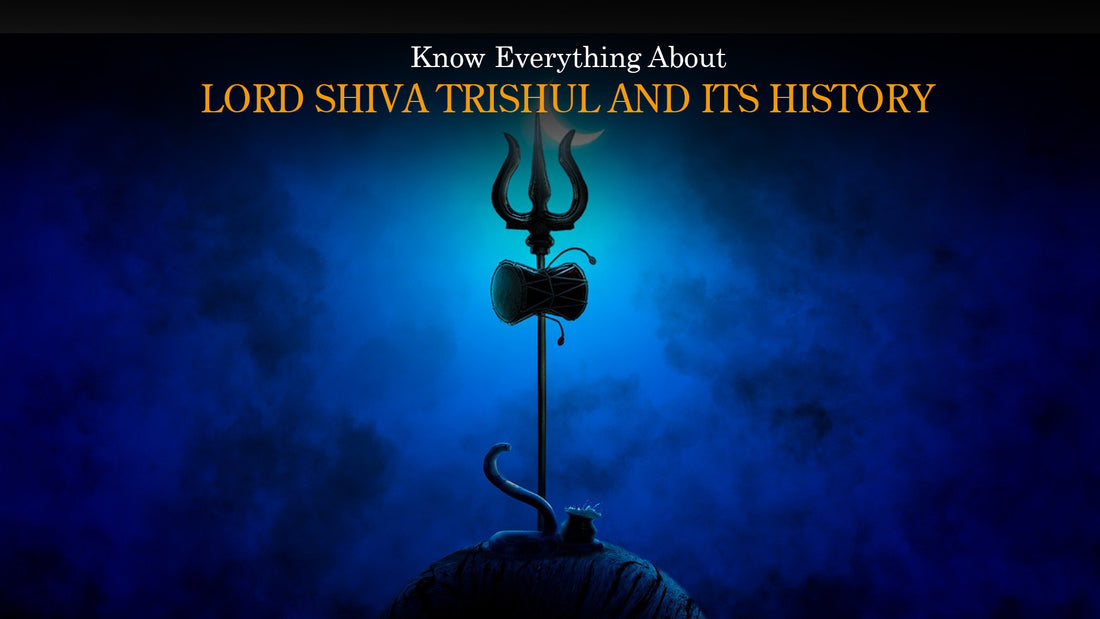Lord Shiva, or Bhole Baba, is a prominent deity in Hinduism. He is revered as one of the principal gods in the Hindu pantheon and is often associated with meditation, asceticism, and destruction.
In Hindu culture, brass Shiva statues and brass Shiv murtis often depict Lord Shiva holding the Trishul, emphasizing its significance as a symbol of divine power and spiritual evolution. Devotees honor Lord Shiva's presence by worshiping brass idols and seeking blessings from Bhole Baba, recognizing the Trishul as a potent instrument of cosmic balance and transformation.
The Trishul, commonly known as the Shiva trident, is a significant symbol associated with Lord Shiva. It is a three-pronged weapon with profound spiritual and symbolic meaning in Hinduism. The Trishul is often depicted alongside Lord Shiva, symbolizing his divine power and cosmic influence.
Trishul as a Symbol of Power and Destruction
The Trishul is a powerful weapon that signifies Lord Shiva's authority over the material and spiritual realms. It is a symbol of strength, control, and the ability to overcome obstacles. The three points of the Trishul represent the power to destroy negativity and ignorance, allowing for the emergence of positive forces.
The Trishul showcases the concept of Trimurti, representing the three fundamental aspects of existence – creation (Brahma), preservation (Vishnu), and destruction (Shiva). Lord Shiv ji Trishul, therefore, signifies his role as the cosmic force responsible for the cyclical processes of creation, preservation, and, ultimately, destruction.
As the destroyer of evil and ignorance, Lord Shiva wields the Trishul to eradicate negativity and pave the way for spiritual enlightenment. The Trishul's sharp points symbolize the eradication of ignorance and the triumph of divine knowledge over darkness. In addition to the Trishul, Lord Shiva is often depicted holding a Damru, a small drum, symbolizing the rhythmic and cyclical nature of the universe.
The association of these symbols emphasizes Lord Shiva's multifaceted role as the cosmic dancer, the destroyer of negativity, and the source of cosmic rhythm and order. Worshippers often seek blessings from Lord Shiva brass idols by offering prayers and displaying brass Shiva statues or brass Shiv murtis, which prominently feature the Trishul as a central element.
Components of the Trishul
The Trishul, often called the Shiva trident, is a distinctive weapon associated with Lord Shiva. It features three prongs or points, each with its symbolic significance. The Trishul's design represents Lord Shiva's power to maintain cosmic order and balance.
In Hindu philosophy, the universe is governed by three fundamental qualities known as Gunas – Sattva (purity, knowledge), Rajas (activity, passion), and Tamas (inertia, darkness). The three prongs of the Trishul symbolize these Gunas, signifying the balance and interplay of these forces in the universe.
Sattva: The first prong represents Sattva, symbolizing purity, harmony, and enlightenment. It reflects the divine knowledge and serenity associated with spiritual awakening.
Rajas: The second prong signifies Rajas, representing activity, desire, and passion. It embodies the dynamic energy that drives action and change in the world.
Tamas: The third prong symbolizes Tamas, representing inertia, ignorance, and darkness. It signifies the state of unconsciousness and the forces of resistance that hinder spiritual growth.
Together, the Trishul reflects these three Gunas' harmonious integration, highlighting the cosmos' dynamic interplay between creation, preservation, and destruction.
The Trishul also serves as a symbolic representation of the three states of consciousness experienced by individuals:
Waking State (Jagrat): The first prong represents the waking state, characterized by awareness of the external world and engagement in worldly activities.
Dreaming State (Swapna): The second prong symbolizes the dreaming state, where individuals experience a realm of imagination and subconscious thoughts during sleep.
Deep Sleep State (Sushupti): The third prong signifies the state of deep sleep, where consciousness is dormant, and individuals experience a state of rest and rejuvenation.
Just as Lord Shiva transcends these states of consciousness, the Trishul represents the journey of self-discovery and spiritual awakening, guiding individuals to realize their true nature beyond the physical world's limitations.
Spiritual Significance of theTrishul
The Trishul, associated with Lord Shiva, holds deep spiritual significance in Hinduism. It is not merely a physical weapon but also a symbol of profound inner transformation and spiritual awakening. The three prongs of the Trishul represent the qualities - Sattva, Rajas, and Tamas - within each individual. By wielding the Trishul, Lord Shiva signifies his power to help seekers overcome negative qualities and attain spiritual enlightenment.
In Hindu rituals and practices, the Trishul plays a significant role as a sacred symbol of Lord Shiva's divine authority and cosmic power. Devotees often offer prayers and perform rituals involving the Trishul to seek protection, guidance, and blessings from Bhole Baba. The presence of the Trishul in religious ceremonies and festivals underscores its importance as a potent emblem of spiritual devotion and divine grace.
The Trishul holds special significance in the practice of Yoga and meditation. Yogis and spiritual seekers often invoke the energy of the Trishul to aid in their inner journey toward self-realization and transcendence. The Trishul's three prongs symbolize the three aspects of Yoga - asana (physical postures), pranayama (breath control), and dhyana (meditation). By embracing the symbolism of the Trishul, practitioners strive to attain harmony between mind, body, and spirit, thereby achieving inner peace and spiritual fulfillment.
Moreover, the rhythmic sound of Lord Shiva's Damru, often depicted alongside the Trishul, is a potent tool for meditation and inner reflection. The vibrations produced by the Damru symbolize the cosmic rhythm of creation and destruction, guiding practitioners toward a deeper understanding of the cyclical nature of existence.

The Trishul holds immense spiritual significance in Hindu culture, serving as a powerful instrument for inner transformation, divine worship, and spiritual evolution. Through its symbolism, devotees seek to align themselves with the cosmic energies represented by Lord Shiva, thereby embarking on a journey of self-discovery and spiritual awakening. Brass Shiva statues and brass Shiv murtis adorned with the Trishul are tangible reminders of Bhole Baba's divine presence (bhole baba ka trishul) and eternal grace, inspiring devotees to walk the path of righteousness and spiritual enlightenment.
Stories Associated with Lord Shiva and His Trishul
Destruction of Tripura
One of the most famous legends associated with Lord Shiva's Trishul is the destruction of the demon Tripurasura. According to Hindu mythology, the demon Tripurasura had obtained immense power and wreaked havoc on the world. Lord Shiva, wielding his powerful Trishul, destroyed the demon's three flying cities (Tripuras), thereby restoring peace and balance to the universe.
Encounter with Andhaka
Another mythological story narrates how Lord Shiva used his Trishul to defeat the demon Andhaka, causing chaos and terror among the gods and humans. With the divine power of his Trishul, Lord Shiva defeated the demon, symbolizing the triumph of righteousness over evil.
The Trishul, associated with Lord Shiva, symbolizes the divine balance of creation, preservation, and destruction. It represents the cosmic forces of existence and is a powerful tool for inner transformation and spiritual awakening.
As we reflect on the profound significance of Lord Shiva's Trishul, we are reminded of the transformative power inherent within each of us. Just as the Trishul represents the triumph of light over darkness, may we strive to overcome ignorance and negativity, embracing the divine light of consciousness and inner peace.
The Trishul is a timeless emblem of spiritual strength and divine grace, guiding humanity toward righteousness and enlightenment. Through its enduring symbolism, Lord Shiva's sacred weapon inspires reverence, devotion, and spiritual awakening among devotees worldwide.
Frequently Asked Questions
What is Shiva's Trishul called?
Shiva's Trishul is called "Trishula." In Sanskrit, "tri" means three, and "shula" means spear or weapon. The Trishula is a three-pronged weapon associated with Lord Shiva and holds deep symbolic significance in Hindu mythology.
What is the Trishul symbol?
The Trishul symbolizes several aspects of Hinduism. It represents Lord Shiva's cosmic power and authority. The three prongs of the Trishul indicate the three fundamental elements of existence - creation, preservation, and destruction. It also signifies the three Gunas (qualities) - Sattva, Rajas, and Tamas.
Where is the tallest Trishul in the world?
The tallest Trishul in the world stands at the Pandaveshwor Temple in Dang, Nepal. Situated about 10 kilometers south of Ghorahi Bazar in the Dang district, this monumental Shiva trident, known as the World's Biggest Trishul, was inaugurated on December 14, 2014. Weighing 81 quintals and 13 kilos, it is a remarkable symbol of devotion to Lord Shiva.
Who gifted Trishul to Shiva?
According to the Vishnu Purana, the master craftsman Vishwakarma created the Trishul using matter from the sun and bestowed it upon Shiva as a divine gift. This underscores the significance of the Trishul as a sacred weapon endowed with celestial power.


